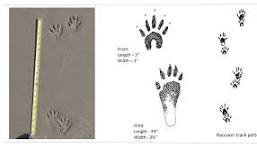Become a Nature Detective: Unravelling the Secrets of Raccoon Tracks
Raccoon tracks are among the most distinctive footprints left behind by wildlife. Whether in the woods, along a riverbank, or in your own backyard, spotting raccoon prints can tell you a great deal about their behavior and movements. This guide will show you how to confidently identify raccoon tracks, differentiate them from similar animal prints, and even preserve them for study.
The Enigmatic Raccoon: A Brief Overview
Raccoons (Procyon lotor) are native to North America and thrive in diverse habitats, from dense forests to bustling cities. Their omnivorous diet—ranging from crayfish and berries to eggs and discarded human food—makes them highly adaptable. This adaptability means you might find raccoon tracks everywhere: from riverbanks to gardens or garages.
Learn more about common species in our backyard animal tracks guide.
Key Features of Raccoon Tracks
Key features:
- Five toes: Long, slender, finger-like toes on both front and hind feet.
- Claws visible: Often leave tiny pinprick marks, especially in mud or snow.
- Palm pad: Roughly C-shaped, with toes connected directly.
- Asymmetry: Tracks are slightly asymmetrical, helping to differentiate left from right.
Front Paw vs. Hind Paw
- Front paw: Wider, more hand-like, 1–2.5 inches long.
- Hind paw: Longer, oblong, 2–4 inches long, with toes pointing straighter forward.
Raccoon Gait and Track Patterns
- Two-by-Two Walk / Alternating Diagonal: Raccoons often pair a front paw with the opposite hind paw, creating a distinctive side-by-side pattern.
- Other gaits: They may lope or gallop when startled or moving quickly.
For more background on gait patterns, visit our wildlife tracking basics guide.
Substrate Influence: How the Ground Affects the Print
- Mud or moist sand: Ideal for sharp impressions.
- Snow: Clear but easily distorted by melting.
- Hard ground: Only partial impressions may register.
Where to Search for Raccoon Tracks
- Near water sources: Creek beds, pond edges, riverbanks.
- Residential areas: Gardens, garbage bins, patios, decks.
- Fence lines & property boundaries: Common raccoon travel routes.
- Vertical surfaces: Look for climbing marks on trees, shrubs, or walls.
- Indoors: Tracks in attics, crawlspaces, or garages if raccoons gain entry.
Differentiating Raccoon Tracks from Look-Alikes
- Raccoon vs Opossum: Opossum hind tracks have a thumb-like toe pointing outward; raccoons’ toes point forward.
- Raccoon vs Skunk: Skunks have smaller tracks with visible negative space between toes and palm.
- Raccoon vs Cat: Cats only show four toes and usually no claw marks.
- Raccoon vs River Otter: Otters have rounder toes and sometimes visible webbing.
Beyond Tracks: Other Signs of Raccoon Activity
- Scat: Dark brown/black, tubular, often with undigested seeds or crayfish parts.
- Scratch marks: On trees, walls, or insulation.
- Sounds: Chittering, growling, or scurrying in attics at night.
- Damage: Tipped trash bins, ripped sod, roof damage.
For more on identifying droppings, read our animal scat guide.
Safety and Conservation Considerations
Raccoon scat may contain dangerous parasites like raccoon roundworm. Always exercise caution and avoid direct contact. If raccoons have entered your home, call professional wildlife removal services.
Learn more at the National Wildlife Federation: Raccoon Facts.
Preserving Your Discovery: Making Plaster Casts of Tracks
Steps to create a plaster cast:
- Find a clear track.
- Place a plastic ring around it.
- Mix plaster of Paris until creamy.
- Pour gently into the ring.
- Let harden for 15–60 minutes.
- Remove and cure for several days.
Practice and Observation Tips for Budding Trackers
- Ask guiding questions: What animal was here? What was it doing?
- Look at stride length and grouping.
- Document with photos and include a size reference.
- Consider the habitat context.
With practice, identifying raccoon tracks will become second nature. Soon, you’ll recognize them as one of the most rewarding clues in your wildlife adventures.
Further Reading:
Images Suggested:
- Raccoon tracks in mud (alt: Raccoon tracks in mud showing five toes and palm pad)
- Comparison chart of raccoon vs opossum tracks (alt: Comparison of raccoon footprints and opossum tracks for identification)
- Raccoon walking along riverbank (alt: Fresh raccoon tracks along sandy riverbank)
- Plaster cast of raccoon footprint (alt: Plaster cast of raccoon track for wildlife study)





